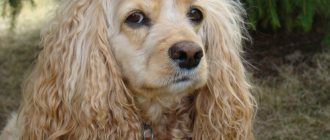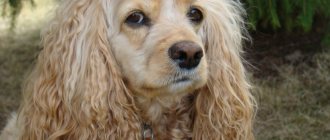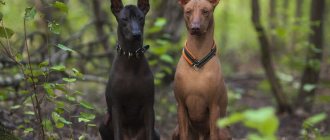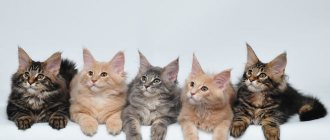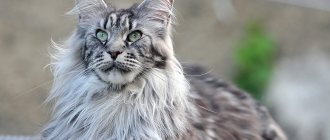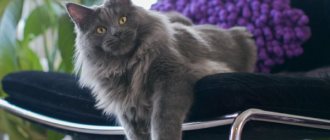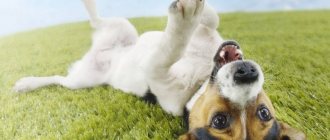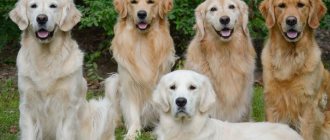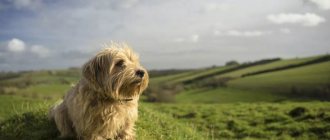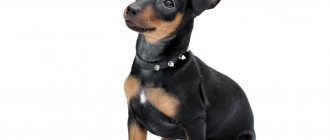For many years, Maine Coons were considered the largest representatives of the cat breeds. Despite the fact that new large pets have appeared in felinology, this breed still remains very popular all over the world and in our country.
The sizes can be medium, but more often large. Today they are one of the largest cats intended for keeping at home. Despite their impressive size and stern appearance, Maine Coons are very friendly to people, strongly attached to their owner, while maintaining feline dignity and independence.
History of the Maine Coon
There are many mysterious stories about the appearance of amazing long-haired cats with tufts on their ears in one of the states of North America - Maine.
"Kun" means "raccoon". And according to one version, it was the mating of this animal with a wild forest cat that gave birth to a new species. But it is unlikely that this legend has any real roots, since interspecific crossing is impossible.
Another story attributes the participation in the appearance of this animal to the North American lynx. The characteristic tassels on the ears suggest this. But geneticists refute this theory too.
There can be only one correct assumption - this variety occurred as a result of a long natural mutation of some wild aboriginal cat species.
Modern representatives of the breed come from Manx cats, which were valued by peasants for their excellent hunting qualities. These large animals coped well with protecting homes, barns and food warehouses, destroying various rodents.
Cat shows are fun that were invented quite a long time ago, and at one of them a cat was presented, which today is considered to be the first representative of the breed.
It was a huge, fluffy handsome man named Captain Jenks from the naval cavalry. It was shown at several exhibitions in the United States in 1861, after which representatives of this breed became very popular.
At the beginning of the 20th century, popularity began to wane; Maine Coons gave way to other cats and could have disappeared completely. This breed was saved by the same peasants and farmers who continued to breed excellent mousecatchers to protect their possessions from rodents.
True origin story
There are several ways to breed a new breed of animal:
- naturally;
- through artificial crossing.
From the point of view of biologists, Maine Coons appeared as a result of natural evolution, namely, they descended from their American ancestors, without human intervention. Their distinctive external features arose as a result of the harsh climate of their place of residence.
Interesting! Over time, the ancestors of the breed adapted to the living conditions - their thick and long hair protected them from the cold, their long paws allowed them to move through the snow without much difficulty, and they rested on their bushy tail.
Appearance description
The Maine Coon looks like a very large cat. But only some representatives of the breed reach great weight. For the most part, this impression is created due to the pet’s long and voluminous fur. The maximum weight of a female individual rarely reaches seven kg, and that of a male - nine. Although this breed is still considered large.
Maine Coon cats can reach a height of 0.4 meters, and a length (taking into account the length of their rather large tail) - 1.2 meters.
Maine Coons develop very slowly. This is the only breed in which maximum weight and body length are formed only at four years of age. From this period they are considered to have reached sexual maturity.
Distinctive features are not only large dimensions, but also cute tufts on the ears, powerful clawed paws with fur growing between the toes, and a luxurious fluffy tail.
Let's look at the standards of this breed:
- the head is quite large, longer than wide, the cheekbones are located relatively high;
- the muzzle is blunt, proportionally located on the head; in profile, such cats do not have an elongated narrow muzzle;
- the ears are quite large, gradually narrowing towards the top, covered with hair, ending in small tassels, located high, with a distance between them approximately equal to the width of the lower part of one ear;
- oval-shaped eyes, the iris can be any color, including blue (in cats that are white or have white spots);
- the Maine Coon's body is distinguished by proportionality, pronounced muscles, strong bones, a wide chest, limbs proportional to size;
- the limbs are straight, the paws are wide, with hair between the toes (there are five toes on the front legs, and four on the hind legs);
- the tail is long (up to 35-37 cm), wide, covered with long hair, straight, wide at the base, tapering towards the tip;
- thick, dense wool, silky to the touch, lengthens on the stomach, forming “pants”, the hair is shorter on the shoulders and chest, and a “collar” on the neck.
If the Maine Coon's coat is short or does not lengthen on the belly and hind legs, this is considered a fault in the breed.
Maine Coon colors are numerous and varied. These can be either solid colors of any color or mixed colors - bicolors, tabbies, torties.
Despite the fact that the natural species had only two shades of wool - black and red, as a result of numerous selections and mutations, the color range became much wider. Nowadays there are Mien Coons of cream, graphite, gray, blue, red, and white colors.
At shows, lavender, Himalayan and chocolate colors are a deviation from the standard and cause for disqualification.
Raccoons from Maine
The history of the Maine Coon breed takes us back to the American state of Maine. It is believed that the cats got their unusual name due to their resemblance to raccoons. Indeed, in appearance, Maine Coons are somewhat similar to raccoons - in build, large tail, color. Even the sounds made by young raccoons are somewhat similar to the purring of a cat. That is why the literal translation of the Maine Coon breed from English will mean: Maine raccoon. The first word is a reference to the name of the state (we'll talk about it later), and the second is a residual from raccoon, which is exactly “raccoon”.
Let's talk about the second one right now. The main legend about the history of the Maine Coon breed is as follows: it was born after crossing a female raccoon with a cat. Well, since they are similar, then there is nothing to deny. However, cats of many other breeds also have stripes similar to raccoons. And the Maine Coon cat got its large shape through natural selection. In addition, the impossibility of interspecific crossing has been scientifically proven. So, solely the evolution of the species and neither the raccoon nor the lynx (the tasseled ears of the Maine Coon remind many of this predator) took part in the breeding of this cat breed.
Character and habits
Maine Coons, for the most part, are friendly, sociable and have a high degree of attachment to the owner and all household members.
Despite the fact that the appearance with a heavy lower jaw creates the impression of isolation and a difficult character, the temperament of these giants is actually peaceful and affectionate.
Cats of this breed need communication, and from childhood they need to be given a lot of attention. Character can be corrected; cats are well-educated if the process is started at an early age.
Also read the article about the most affectionate cat breeds.
Maine Coons love communication, especially with people, but they also find a common language with other representatives of the animal world, if they are not in conflict. They love attention and love to be petted. Due to natural curiosity and inquisitiveness, they quite easily make contact with unfamiliar people and animals. This trait is especially characteristic of males; cats are more cautious and distrustful.
As a rule, the Maine Coon is a fairly independent animal that will not particularly bother its owner by hanging around under his feet. But some cats love to demand attention and can be somewhat intrusive. However, for a loving owner this disadvantage is not so great.
Representatives of this breed, as a rule, become attached to one person, who is considered the owner, but they also show friendliness to other family members. The love and loyalty of Maine Coons is often compared to that of a dog, and this is true: they love their owners very much.
Typically, cats are attached to their home, but representatives of this breed easily adapt to any environment, as long as their loved one is nearby.
Another feature of the Maine Coon is its love for walks. These cats are very curious and enjoy being outside.
If you accustom your pet to a harness and leash from early childhood, then he will not experience discomfort while walking “on a leash,” as long as the leash is long enough and allows him to explore as many interesting places as possible from a cat’s point of view.
Training and communication
Maine Coons are very sociable animals; they love to be in human company. Pets need to be raised from as early an age as possible.
The first thing cats must learn is to use the toilet, as well as a scratching post. This breed is highly trainable; they can easily be taught anything using carrots and sticks. But do not overdo it with the punishment system, otherwise the stress-prone animal will feel bad. For example, you can wean an animal from jumping on a sleeping bed or scratching a sofa using a spray bottle. The water in it should be warm, you need to splash the animal very little: do not allow the fur to be too wet so that water gets into the eyes.
Before punishing an animal for disobedience, think about whether it is to blame for the current situation. Perhaps you yourself did not take care of finding a comfortable place to sleep, or installing a scratching post or tray in an insufficiently secluded place.
Features of maintenance and care
The Maine Coon is a large, strong and active cat, and this must be taken into account when planning to purchase a pet of this breed. These cats need space, they like to explore high places in the apartment and play actively.
The best option would be a special corner for cats, with platforms of varying heights and a house.
If the cat does not exercise enough, this will lead to obesity and various diseases, which will negatively affect life expectancy.
In the absence of a special corner, you can equip a bookshelf for your pet, hanging it on the wall, or a chair intended only for it. It is important for the Maine Coon to know that he has a personal space that he can inhabit as he pleases (although cat owners know that he usually considers the entire apartment to be such space).
When getting a pet, every person should remember that he needs attention and care, then he will live long and happily. In order for the animal to be healthy, it is necessary to regularly show it to the veterinarian for medical examination.
In addition, the mustachioed friend needs vaccination.
The first vaccination is given at the age of two months; it develops complex immunity to viral infections, chlamydia, tracheitis and pylencopenia. The following are done according to the schedule recommended by the veterinarian (there are special instructions that indicate the approximate vaccination schedule). It is developed taking into account not to overload the animal’s body with drugs, but also in such a way that by the age of teething (when the immune system is significantly weakened) the necessary protection is formed.
The second vaccination is given to the cat at approximately three months of age; it must be vaccinated against rabies. The next procedure is per year, and then annually or as necessary. 10 days before vaccination, the kitten must take a course of antihelminthic medications.
Immediately before vaccination, the cat will be examined by a veterinarian, since the procedure can only be performed on a completely healthy animal.
To improve your pet’s immune status, the health of its eyes, fur, teeth, and musculoskeletal system, you should regularly give it vitamin complexes. It is better to select them together with a veterinarian. He will advise which vitamins are most suitable for a particular cat.
Antiparasitic drugs must be given in courses, regularly. It is also necessary to regularly treat for fleas and ticks. All these measures are especially necessary for Maine Coons who walk outside.
Representatives of the breed are very clean, constantly washing themselves and licking their fur. It accumulates in lumps in the stomach and is periodically regurgitated naturally. But if the owner wants to take care of the health of the furry pet, then the animal should be given special pastes that help remove hairballs from the gastrointestinal tract.
In some cases, hairballs are so large that they can block the intestinal lumen, causing obstruction. This is a dangerous condition, so it is better to take care of hair removal in advance.
In order to improve digestion, felinologists also recommend purchasing special pots of weed or growing it at home yourself. Cats nibble grass, which helps cleanse their intestines better.
Maine Coons have luxurious thick hair, which in natural conditions helped them easily endure the rather harsh climate of their homeland. A cat living at home needs help in caring for his luxurious fur coat. The animal should be combed 1-2 times a week, and during the molting period - even more often, daily. It doesn't take much time, and many cats even really like the procedure.
For combing, a natural bristle brush or a fine-toothed comb with a metal base is suitable. Long, thick hair can become tangled, especially if brushing is not done regularly. You can try to carefully separate the matted wool with your fingers, and if that doesn’t work, then cut it off.
Most often, Maine Coon hair falls off on its “pants.” In order not to cause discomfort and pain to your pet, before combing it is necessary to check for the presence of tangles.
You should bathe regularly, using special shampoos and conditioners. A special feature of this breed is a noticeable love for these procedures: many of them love to play with a trickle of water, splash around, drink from the tap and even take a full bath. Because of this feature, they tolerate the washing procedure quite easily and even with pleasure.
Before bathing your pet, you need to make sure that water does not get into its large ears. To do this, you need to protect them with cotton swabs.
Caring for a cat of this breed also includes regular cleaning of the ears with a special solution, teeth and claw trimming. You can do all these procedures yourself, or you can take your pet to a groomer and veterinarian.
Legends of origin
The state of Maine in America is considered to be the place of origin of Maine Coon cats, but the variants of their appearance are strikingly different from each other.
Marriage between a cat and a raccoon or lynx
The essence of this myth is that cats brought to America from Asia crossed with raccoons. Proponents of this theory cite the color of the Maine Coon's coat and the appearance of its tail as evidence.
No less popular is the legend about the connection between a lynx and a cat, which led to the appearance of Maine Coons - it arose due to the characteristic tufts on the pets' ears.
In turn, from a genetic point of view, such unions cannot exist, since animals of these species differ in the set of chromosomes.
Cat on a ship
There are several sea stories about the appearance of Maine Coons:
- One of them tells the story of Captain Kun, nicknamed “Raccoon” by the sailors. He went on his voyages with his favorite pets - a cat and cats, distinguished by their large size and long fur. On the ship they ate mice, thereby protecting the crew's supplies from spoilage. After each call to the port, the animals gave birth to offspring, and Kun gave some of the grown kittens to his friends.
- Another version of the story of the original origin of cats of this breed is based on the fact that “Raccoon” distributed kittens to residents of Maine. Growing up, they created alliances with American cats and female cats, which was the reason for the appearance of the Maine Coon representatives.
- The third myth is that Scandinavian sailors took cats on board their ships to hunt rats. They chose hardy, large-sized specimens accustomed to difficult living conditions. In ports, animals came onto land and mated with local cats.
- There is also an opinion that cabin boy Tom Coon sold kittens in Maine that were born on the ship during the voyage - they became the first representatives of the Maine Coon breed.
There is a legend that the ancestors of these cats are animals that survived before the destruction of Atlantis. One of these cats ended up in Russia and became the ancestor of Siberian seals. Another led to the appearance of representatives of the Norwegian breed, and the third led directly to the Maine Coons.
Maine Coon's relationship with the queen
Another historical hypothesis concerns the accidental participation of the French Queen Marie Antoinette in the appearance of the Maine Coon breed. In the summer of 1791, the couple of monarchs attempted to escape from Paris, gripped by revolutionary madness, where the family was under virtual arrest in the Tuileries Palace.
The Queen decided to escape away from the Old Continent and even ordered that personal belongings, jewelry and her favorite Turkish Angora cats be sent overseas in advance.
The prisoners managed to leave the palace, but were stopped by the rioting people, handed over to the national guard and returned - the escape was unsuccessful. In January 1793, Louis XVI was executed, and his wife survived her husband by only 9 months and ended her earthly journey on the scaffold.
And purebred royal cats took root in America; they began to be crossed with local short-haired cats. This is how a version arose that the ancestors of Maine Coons were bred with the participation of royal pets.
This is interesting! If we accept this version of the origin of the big cat as true, then we should appreciate the paradoxical irony of fate - today the rules for breeding Maine Coons prohibit crossing with any breeds except three native species. The Turkish Angora is not among these exceptions.
Viking deity
Some scientists attribute the origin of the Maine Coon to the Vikings. More than a thousand years ago, Scandinavian warriors landed from ships on the coast of America and even founded several settlements. But they did not find a common language with the warlike Indian tribes and were forced to retreat, leaving the New World until the arrival of Columbus.
The cats that accompanied the Vikings during their journey remained to live in the new territory. The version is supported by references to the Scandinavian goddess Freya, the patroness of love and war. According to legend, she often rode a chariot drawn by forest cats. And the harsh conquerors took these animals with them on risky journeys to appease their idol.
The population adapted to the new conditions and degenerated into Maine Coons. Moreover, the purebred Norwegian forest cat is very similar to the American giant and is even distantly related genetically. It turns out that the Vikings brought four-legged pets to a distant continent, but it was the Indians who bred Maine Coons.
This is interesting! The Norwegian Forest Cat belongs to the aboriginal groups with which Maine Coons are allowed to be crossed in order to improve their breed qualities.
Other versions
Experts are a little skeptical about the romantic legends about the origin of the popular breed. Most felinologists adhere to the version that the history of the breed began with the crossing of local short-haired cats with their long-haired relatives, brought by sailors to the American continent from Europe.
Official felinology holds the following opinion about the Maine Coon breed: the first Maine cat was born from a union between a long-haired forest cat that arrived from Europe with the Viking pioneers, and a North American aboriginal cat, which was not yet domesticated.
Centuries passed, and gradually, under the influence of the harsh climate of the East Coast, the standard of the Maine Coon breed was formed - powerful, handsome cats, distinguished by magnificent hair, thick and silky, capable of protecting from frost and cold winds, as well as an imperturbable Nordic character. Today, the Maine cat is one of America's national treasures, and rightly so.
Aborigines of the Isle of Man
All breeds can be divided into two types:
- artificially bred;
- Aboriginal.
Artificial breeds were formed by people through crossing, but with native ones everything is a little more complicated. In a certain environment, a certain population is formed, it adapts to the climate, consolidates its main features, and the fittest individuals survive and develop.
Kosei cat, the first representative of the breed presented at the cat exhibition in 1895.
The native cats, from which the modern breed began, developed in harsh conditions. The North American state of Maine is characterized by cool summers and long, cold winters. In such a difficult climate, the ancestors of modern cats had to lead a predatory lifestyle in order to compete with other animals.
The cats were distinguished by a long, dense fur coat, a fluffy tail and a strong, muscular body. A thick fur coat provided protection in winter, and long legs helped to move through the snow. The huge tail allowed them to sleep on snow cover and in cold burrows. By wrapping themselves in their tails, they protected their sides and belly from freezing. Long mustaches helped hunters navigate at night; the ancestors of the Coons ate mainly birds and rodents - sharp teeth served as good weapons.
Modern Maine Coons sometimes resemble their relatives. Some animals have powerful fangs protruding from under the upper jaw. The elongated snout allowed predators to hold large prey.
For a long period of time they lived near farms, protecting supplies from rodents. Villagers viewed cats as hunters and were of little interest to their pets' appearance. Maine Coons were considered excellent rat catchers; residents tamed the animals to protect barns from mice. Gradually, the appearance of American cats began to gain popularity. In addition, the animals were distinguished by their friendly nature, and they began to be appreciated. Events took place 150 years ago. The Kuna began to spread deeper into the continent.
Reliable information about the breed begins to appear in the mid-nineteenth century. At this time, a cat exhibition is taking place, at which one participant presents a new breed - the “raccoon cat”. The large, long-haired cat quickly gained popularity.
Feeding
The Maine Coon does not require a particularly special diet, but it is important to consider that it is a large and active animal. Nutrition should be complete and varied, including all the vitamins and microelements necessary for the animal. Experts do not give clear recommendations regarding whether to give dry or canned food to your pet.
As a rule, it is advised to feed mostly dry food, and offer canned food several times a week. All quality cat food manufacturers have special lines designed specifically to meet the needs of large cats. So they are suitable for Maine Coon.
In any case, homemade food is not suitable for Maine Coons, although some owners prefer to feed their pets this way.
You can give your cat natural food, but then you need to carefully select his diet. About three quarters should be various types of meat, and only a quarter should be milk and dairy products, seafood, eggs, and vegetables. With such a diet, it is important to give your pet vitamin and mineral supplements to its food.
Food specially produced for cats contains the substances necessary for the animal; high-quality dry food is an excellent prevention of tartar. Breeders recommend choosing dry food and canned food, the main component of which is some kind of meat.
For Maine Coons, food based on any grain crops is contraindicated, since genetically these cats are not predisposed to digest them. This is due to the fact that in natural conditions their ancestors never ate grain, and such feeding can cause various diseases in the pet, in particular diabetes or obesity.
It is not recommended to mix natural food and specially produced food, and you should not constantly change them or use several brands at once. It is better to accustom your pet to the diet of one manufacturer from childhood and not to use others unless absolutely necessary.
Dishes intended for the animal are important. It is best to purchase metal or glass bowls. This can be dishes made from any natural material, but not plastic.
Plastic feeders can cause allergies and other unpleasant ailments.
Reviews
The description of the breed in reviews of Maine Coons is mentioned most often. Every owner can spend hours admiring their pet. Owners write enthusiastically in reviews about the size of the cats, which impresses everyone they know, about the tufts on the ears, and the fluffy tail. Breeders note the animal's sweet and cheerful disposition. The ease of care makes the breed very easy to keep. Maine Coons very quickly get comfortable in any home and feel like full members of the family. The cute creature, despite its large size, is distinguished by its mobility and will not let its owners get bored. But at the same time, Maine Coons are not prone to mischievous tricks, after which the whole house is upside down. The breed is good in many respects, for which it has earned universal love.
Health
Maine Coons are distinguished by excellent health, which is due to their origin and genetic adaptation to survival in the harsh conditions of long winters.
According to statistics, the life expectancy of representatives of this breed is 13 years or more. More than half of the cats recorded live for more than 16.5 years.
The most serious health problems in Maine Coons are the same as in humans - diseases of the cardiovascular system.
Hypertrophic cardiomyopathy is the most common pathology in cats, including representatives of this breed.
As a rule, this disease affects cats of middle and old age, so it is important to monitor the health of your pet and regularly show it to the veterinarian, since with timely diagnosis the disease can be corrected.
Another problem that can arise in this breed is spinal muscular atrophy. This pathology is also inherited by cats in an autosomal recessive manner and is characterized by damage to the nerve fibers of the spinal cord responsible for the innervation of the muscles of the skeleton and limbs. This disease manifests itself early in kittens, as early as three or four months of age.
The disease prevents the animal from jumping high, but in general these babies eat well, play well and can live well for a long time, like all other cats.
The musculoskeletal system of a pet of this breed can be affected by a disease such as hip dysplasia. This is also a hereditary disease, which most often manifests itself in old age, mainly in males: they begin to suffer from arthritis and limp. Maine Coons can also get sick with another genetically determined disease - polycystic kidney disease.
In general, the likelihood of serious illnesses in representatives of this breed is quite low: they have excellent heredity, since the health of Maine Coons was formed through natural selection, and not selection.
Cost of a kitten
A kitten of this breed is quite an expensive pleasure. Prices vary greatly depending on the purpose for which the pet is purchased: for exhibitions, breeding, or, as they say, “for the sofa.”
Kittens that meet the breed standard are usually purchased in order to be bred and shown at various competitions. The cost of such individuals starts from 100 thousand rubles, and this is far from the limit. The price is determined by the breeders themselves, and may vary depending on the region.
Kittens that have any deviations from the standards are cheaper, but also not cheap - about 60 thousand rubles. Such a cat will not be accepted for an exhibition and is not suitable for breeding, but this does not mean that he cannot become a wonderful friend, companion and favorite of the whole family.
Photo gallery of Maine Coons:
The breed today
Marble tabby color
At first, only the color “black marble” was recognized. But later the standards became more and more lenient. Today all color variations are recognized. The breed experienced a surge of curiosity and recognition, then interest in big cats faded. The second round of popularity began in the mid-twentieth century. Today the breed is among the top five.
Maine Coons appeared in Russia in the early nineties. Over the years, many nurseries have appeared, releasing thousands of kittens into the world. We can say with confidence that cats with a unique history are not going to give up their position.
Interest in unusual cats is growing - who wouldn’t want to own a large predator shrouded in a mysterious origin story?
